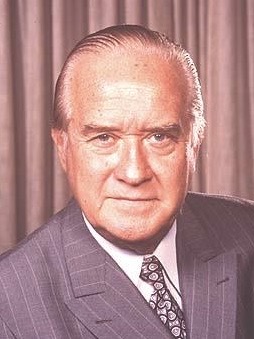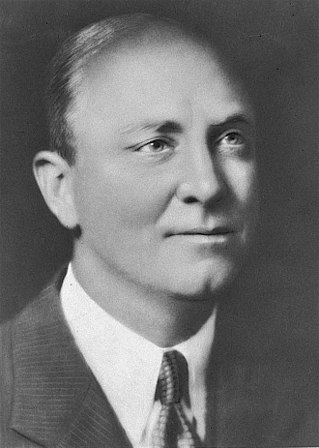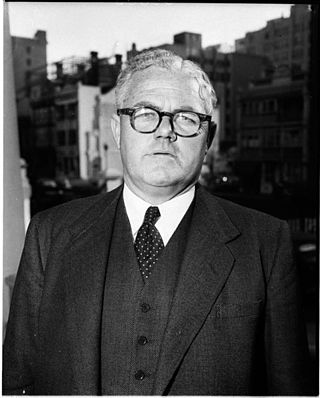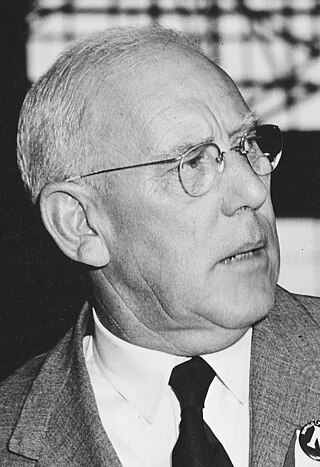
Sir Robert William Askin, GCMG, was an Australian politician and the 32nd Premier of New South Wales from 1965 to 1975, the first representing the Liberal Party. He was born in 1907 as Robin William Askin, but always disliked his first name and changed it by deed poll in 1971. Before being knighted in 1972, however, he was generally known as Bob Askin. Born in Sydney in 1907, Askin was educated at Sydney Technical High School. After serving as a bank officer and as a Sergeant in the Second World War, Askin joined the Liberal Party and was elected to the seat of Collaroy at the 1950 election.

Albury is an electoral district of the Legislative Assembly in the Australian state of New South Wales. It is currently held by Justin Clancy of the Liberal Party.

James McGirr was an Australian politician. He served as premier of New South Wales from 1947 to 1952, holding office as leader of the Australian Labor Party (ALP). He led the party to victory at the 1947 and 1950 New South Wales state elections. He was a pharmacist by profession and the younger brother of Patrick and Greg McGirr, who were also members of parliament; Greg also led the ALP briefly but was never premier.

Alexander Mair was an Australian politician who served as Premier of New South Wales from 5 August 1939 to 16 May 1941. Born in Melbourne, Mair worked in various businesses there before moving to Albury, New South Wales where he went on to be a member of the New South Wales Legislative Assembly for fourteen years. In 1932, Mair was elected to the seat of Albury and was re-elected a further four times. He rose quickly through the cabinet of Bertram Stevens' United Australia Party government, becoming an Assistant Minister in April 1938, Minister for Labour and Industry in June and Colonial Treasurer in October.

Wagga Wagga is an electoral district of the Legislative Assembly in the Australian state of New South Wales. The district has been held by Independent MP Joe McGirr since the September 2018 by-election.

Lieutenant Colonel Sir Michael Frederick Bruxner was an Australian politician and soldier, serving for many years as leader of the Country Party in New South Wales. Born in the north of the state, Bruxner was educated at The Armidale School and started studies at University of Sydney but later dropped out to take up employment as a grazier and station agent in Tenterfield. After serving in the Citizen Military Forces from 1911, Bruxner enlisted into the Australian Light Horse upon the outbreak of the First World War in 1914. Serving with distinction in Gallipoli, Egypt and Palestine, he was promoted to lieutenant colonel and awarded the Distinguished Service Order.
Members of the New South Wales Legislative Assembly who served in the 34th parliament held their seats from 1944 to 1947. They were elected at the 1944 state election, and at by-elections. The opposition Democratic Party merged into the nascent Liberal Party in late 1944, becoming the New South Wales branch of the new party. The Speaker was Daniel Clyne.

Philip Henry (Pat) Morton was an Australian businessman and politician. Born in Lismore in Northern New South Wales to a prominent political family and educated at Lismore High School, Morton left school at fourteen to be employed in a legal firm, before branching out into various businesses. Moving to Sydney, Morton first entered politics in 1944 as an Alderman on Mosman Municipal Council, rising to be Mayor in 1946. Morton then entered the New South Wales Legislative Assembly on 3 May 1947, representing the Electoral district of Mosman for the Liberal Party.

Sir Vernon Haddon Treatt was an Australian lawyer, soldier, Rhodes Scholar and politician. Born in Singleton, New South Wales and educated at Shore School, Treatt interrupted his studies at the University of Sydney to enlist at the outbreak of the First World War. Serving in the Royal Australian Artillery, Treatt served in France and was awarded the Military Medal. Upon returning to Australia he was awarded a Rhodes scholarship and further educated at New College, Oxford.

The 1938 New South Wales state election was held on 26 March 1938. This election was for all of the 90 seats in the 32nd New South Wales Legislative Assembly and was conducted in single member constituencies with compulsory preferential voting.

The 1941 New South Wales state election was held on 10 May 1941. This election was for all of the 90 seats in the 33rd New South Wales Legislative Assembly and was conducted in single-member constituencies with compulsory preferential voting.

The 1950 New South Wales state election was held on 17 June 1950. It was conducted in single member constituencies with compulsory preferential voting and was held on boundaries created at a 1949 redistribution. The election was for all of the 94 seats in the Legislative Assembly, which was an increase of 4 seats since the previous election.

The 1953 New South Wales state election was held on 14 February 1953. It was conducted in single member constituencies with compulsory preferential voting and was held on boundaries created at a 1952 redistribution. The election was for all of the 94 seats in the Legislative Assembly.
Christopher Baron Lethbridge was an Australian politician and a member of the New South Wales Legislative Assembly between 1937 and 1946. He was an Independent member of parliament.

The 1944 New South Wales state election was held on 27 May 1944. It was conducted in single member constituencies with compulsory preferential voting and was held on boundaries created at a 1940 redistribution. The election was for all of the 90 seats in the Legislative Assembly.
A by-election was held for the New South Wales Legislative Assembly seat of Albury on Saturday 9 November 1946.

The McKell ministry (1944–1947) or Second McKell ministry was the 51st ministry of the New South Wales Government, and was led by the 27th Premier, William McKell, of the Labor Party. The ministry was the second of two occasions when the Government was led by McKell, as Premier.

The McGirr ministry (1947) or First McGirr ministry was the 52nd ministry of the New South Wales Government, and was led by the 28th Premier, Jim McGirr, of the Labor Party. The ministry was the first of three occasions when the Government was led by McGirr, as Premier.

The McGirr ministry (1950–1952) or Third McGirr ministry was the 54th ministry of the New South Wales Government, and was led by the 28th Premier, Jim McGirr, of the Labor Party. The ministry was the third and final of three consecutive occasions when the government was led by McGirr, as Premier.
Corowa, an electoral district of the Legislative Assembly in the Australian state of New South Wales had two incarnations, from 1904 until 1920 and from 1927 until 1950.














